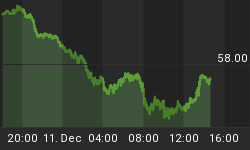The Era of Simple Solutions continues to unfold. For every complex problem, as the wise man once said, there is a simple solution, that is wrong. Into the abyss of collapsing financial institutions rode the Federal Reserve, with a check book in each hand. The crowd went wild over this simple solution. And in response to the fundamental failure of U.S. auto companies, welfare checks were mailed to them. But yet, that is not enough. As a remedy for the economic ills brought on by the housing debt bubble, the Obama government will borrow about $2.5 trillion dollars in the coming year. One of those trillion dollars will be frittered away on Congressional pork and mailing checks to voters. The question is simple. If debt is the solution to economic ills, why is the U.S. economy plunging into recession? Or, is the reason the U.S. economy is plunging into recession because of too much debt?

In this week's first chart is plotted the year-to-year change in the size of the Federal Reserve's balance sheet. In particular, it is the asset side of the balance sheet. That is where so much of the questionable debt created in recent years now resides. Federal Reserve has now purchased or taken as collateral assets in such quantity that its balance sheet, adjusted, is almost a 130% larger than a year ago. Never in the history of any major nation has so much questionable debt been monetized by the central bank.
General consensus among main stream economists is that if the Federal Reserve had acted aggressively, as it is now doing, the Great Depression might have been voided or avoided, your choice. Few, if any, of the advocates for this policy were critical of the previous policies of the central banks which were the root cause of the current economic mess. If any immediate criticism might exist, it is the assumption that all unintended or unexpected consequences of this "banana republic" monetary policy will be positive.
Our second chart, below, considers one consequence of a central bank balance sheet growing without restraint. Plotted in that chart is the annualized growth rate for the U.S. money supply, M-1 and M-2. These measures are calculated from the approximate start of Federal Reserve intervention. M-1, NSA, is growing at an annualized rate of more than 40%. We are led to believe that this plethora of money can only have positive consequences. Only good is presumed to come about from a "printing press" in maximum on mode. And note, these measures do not yet fully reflect the growth of the balance sheet of the Federal Reserve. This is only the beginning!

If a 120+% growth rate for Federal Reserve assets and a 40+% growth rate for the U.S. money supply are good, only great may yet to come. What if the U.S. money supply should double, or rise by 100%. Will only positive economic consequences follow from that? Is some skepticism unreasonable?

One consequence of these developments is shown in the last chart of our dollar index, one not distorted as the popularly used measure. The shortage of U.S. dollars has been remedied, and the value of the dollar has topped. That topping of the dollar has been paralleled by a rise in the dollar price of Gold. While moving into a new down trend, the U.S.$ is over sold. A bounce, such as that which developed on Monday, is likely. It should then move into a negatively sloped channel. A reasonable target for the dollar's fall is 50%.
While all of this is extremely positive for the price of Gold, none of it really a secret. Gold has moved higher in part due to the developing deluge of U.S. dollars. Year end window dressing by portfolio managers and buying by momentum players have also helped Gold rise. However, $Gold does seem to be somewhat over bought as this week opened. A resting period is possible that should allow the over bought condition to dissipate. Investors should prepare to buy Gold if any price weakness develops as new year giddiness and Obama euphoria unfold.
GOLD THOUGHTS come from Ned W. Schmidt,CFA,CEBS as part of a joyous mission to save investors from the financial abyss of paper assets. He is publisher of The Value View Gold Report, monthly, and Trading Thoughts, weekly. To receive these reports, go to http://home.att.net/~nwschmidt/Order_Gold_EMonthlyTT.html.
















